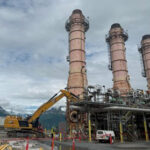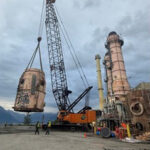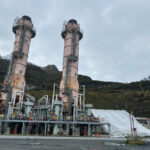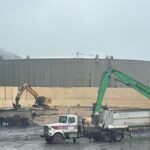From: Alyeska Corporate Communications
The summer of 2025 was a busy one on the Valdez Marine Terminal, or VMT, and much of the work was visible from across the bay as major structures were removed from the 1000-acre facility on the south shore of Port Valdez. Whether the projects made room for newer and more efficient equipment, supported the integrity of critical tanks and piping, or removed out-of-service structures, they all support another 50 years of safe and reliable operations.
Tank 5
East Tank Farm Crude Tank 5 had its internal inspection during the summer of 2025. During this in-depth maintenance, the tank was emptied, cleaned, inspected, and coated. Patch repairs to the floor were made where needed to extend the life of the floor plates.
Tank 5 branch leg inspection
Piping around Tank 5 also got a closer look this summer, specifically a challenging run of pipe that carries crude oil into the tank. Much of the pipe can be externally inspected, but the pipe goes underground and has not been looked at since construction. After modifications were made to enable an in-line inspection tool launch, crews used the tool to inspect the segment.
Berth 1 Structure Removal
The VMT’s Loading Berth 1, long out-of-service, got a facelift this summer as crews removed the Berth Operations Center and other structures on the floating berth. The changes will facilitate snow removal and make eventual removal of the berth easier.
A-incinerator demolition
A-incinerator was one of three incinerators that featured prominently in the Power Vapor complex and on the VMT skyline, and the first to be disassembled this summer. Typically, one incinerator is out of service for maintenance each year, so working without one will not impact operations. A-incinerator’s replacement, a safer and more reliable propane-fueled vapor combustor, will arrive in 2026. It will also require less fuel, reducing emissions from the facility.
Tank 92 Demolition
Out of service since 2008, a contractor with special equipment “snipped” the ballast water settling tank into several pieces, which were then picked up via an excavator with a magnetic attachment. The top of the tank, which was reinforced with extra steel to protect against the wind, proved challenging but the work was completed on schedule. All that remains is a gravel pad.
Photo Gallery:




